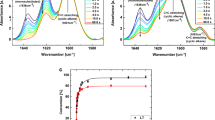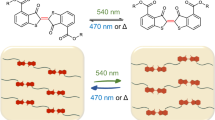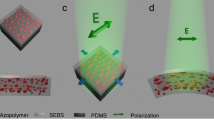Abstract
The development of polymers with switchable glass transition temperatures (Tg) can address scientific challenges such as the healing of cracks in high-Tg polymers and the processing of hard polymers at room temperature without using plasticizing solvents. Here, we demonstrate that light can switch the Tg of azobenzene-containing polymers (azopolymers) and induce reversible solid-to-liquid transitions of the polymers. The azobenzene groups in the polymers exhibit reversible cis–trans photoisomerization abilities. Trans azopolymers are solids with Tg above room temperature, whereas cis azopolymers are liquids with Tg below room temperature. Because of the photoinduced solid-to-liquid transitions of these polymers, light can reduce the surface roughness of azopolymer films by almost 600%, repeatedly heal cracks in azopolymers, and control the adhesion of azopolymers for transfer printing. The photoswitching of Tg provides a new strategy for designing healable polymers with high Tg and allows for control over the mechanical properties of polymers with high spatiotemporal resolution.
This is a preview of subscription content, access via your institution
Access options
Subscribe to this journal
Receive 12 print issues and online access
$259.00 per year
only $21.58 per issue
Buy this article
- Purchase on Springer Link
- Instant access to full article PDF
Prices may be subject to local taxes which are calculated during checkout






Similar content being viewed by others
References
Colquhoun, H. M. Self-repairing polymers: materials that heal themselves. Nat. Chem. 4, 435–436 (2012).
Yang, Y. & Urban, M. W. Self-healing polymeric materials. Chem. Soc. Rev. 42, 7446–7467 (2013).
Fiore, G. L., Rowan, S. J. & Weder, C. Optically healable polymers. Chem. Soc. Rev. 42, 7278–7288 (2013).
Wu, S. et al. Supramolecular bisazopolymers exhibiting enhanced photoinduced birefringence and enhanced stability of birefringence for four-dimensional optical recording. J. Mater. Chem. 20, 5202–5209 (2010).
Kravchenko, A., Shevchenko, A., Ovchinnikov, V., Priimagi, A. & Kaivola, M. Optical interference lithography using azobenzene-functionalized polymers for micro- and nanopatterning of silicon. Adv. Mater. 23, 4174–4177 (2011).
Kucharski, T. J. et al. Templated assembly of photoswitches significantly increases the energy-storage capacity of solar thermal fuels. Nat. Chem. 6, 441–447 (2014).
Baroncini, M. et al. Photoinduced reversible switching of porosity in molecular crystals based on star-shaped azobenzene tetramers. Nat. Chem. 7, 634–640 (2015).
Yu, Y. L., Nakano, M. & Ikeda, T. Directed bending of a polymer film by light—miniaturizing a simple photomechanical system could expand its range of applications. Nature 425, 145 (2003).
Zhang, L., Liang, H., Jacob, J. & Naumov, P. Photogated humidity-driven motility. Nat. Commun. 6, 7429 (2015).
Velema, W. A. et al. Optical control of antibacterial activity. Nat. Chem. 5, 924–928 (2013).
Akiyama, H. & Yoshida, M. Photochemically reversible liquefaction and solidification of single compounds based on a sugar alcohol scaffold with multi azo-arms. Adv. Mater. 24, 2353–2356 (2012).
Okui, Y. & Han, M. Rational design of light-directed dynamic spheres. Chem. Commun. 48, 11763–11765 (2012).
Hoshino, M. et al. Crystal melting by light: X-ray crystal structure analysis of an azo crystal showing photoinduced crystal–melt transition. J. Am. Chem. Soc. 136, 9158–9164 (2014).
Ishiba, K. et al. Photoliquefiable ionic crystals: a phase crossover approach for photon energy storage materials with functional multiplicity. Angew. Chem. Int. Ed. 54, 1532–1536 (2015).
Uchida, E., Azumi, R. & Norikane, Y. Light-induced crawling of crystals on a glass surface. Nat. Commun. 6, 7310 (2015).
Kim, D. Y., Tripathy, S. K., Li, L. & Kumar, J. Laser-induced holographic surface-relief gratings on nonlinear-optical polymer-films. Appl. Phys. Lett. 66, 1166–1168 (1995).
Rochon, P., Batalla, E. & Natansohn, A. Optically induced surface gratings on azoaromatic polymer-films. Appl. Phys. Lett. 66, 136–138 (1995).
Karageorgiev, P. et al. From anisotropic photo-fluidity towards nanomanipulation in the optical near-field. Nat. Mater. 4, 699–703 (2005).
Yager, K. G. & Barrett, C. J. in Polymeric Nanostructures and Their Applications (ed. Nalwa, H. S.) Ch. 8 (American Scientific, 2006).
Lee, S., Kang, H. S. & Park, J. K. Directional photofluidization lithography: micro/nanostructural evolution by photofluidic motions of azobenzene materials. Adv. Mater. 24, 2069–2103 (2012).
Kang, H. S., Kim, H. T., Park, J. K. & Lee, S. Light-powered healing of a wearable electrical conductor. Adv. Funct. Mater. 24, 7273–7283 (2014).
Lee, S., Kang, H. S. & Park, J. K. High-resolution patterning of various large-area, highly ordered structural motifs by directional photofluidization lithography: sub-30-nm line, ellipsoid, rectangle, and circle arrays. Adv. Funct. Mater. 21, 1770–1778 (2011).
Vapaavuori, J., Laventure, A., Bazuin, C. G., Lebel, O. & Pellerin, C. Submolecular plasticization induced by photons in azobenzene materials. J. Am. Chem. Soc. 137, 13510–13517 (2015).
Ikeda, T. & Tsutsumi, O. Optical switching and image storage by means of azobenzene liquid-crystal films. Science 268, 1873–1875 (1995).
Cappella, B. Mechanical properties and adhesion of a micro structured polymer blend. Polymers 3, 1091–1106 (2011).
Bandara, H. M. D. & Burdette, S. C. Photoisomerization in different classes of azobenzene. Chem. Soc. Rev. 41, 1809–1825 (2012).
Andrews, R. J. & Grulke, E. A. in Polymer Handbook 4th edn (eds Brandrup, J. et al.) VI 193–VI 278 (Wiley, 1999).
Acknowledgements
This work was supported by the Deutsche Forschungsgemeinschaft (DFG, WU 787/2–1). H.Z. was supported by the MPG-CAS Joint Doctoral Promotion Programme (DPP). C.X. was supported by the CSC programme. S.H. and G.K.A. acknowledge support by DFG through SPP 1681, project no. AU321/3-1. The authors thank G. Fytas, G. Floudas and T. Bereau for helpful discussion and G. Kircher, U. Rietzler, J. Thiel and A. Hanewald for technical support.
Author information
Authors and Affiliations
Contributions
S.W. conceived the idea and led the project. S.W., K.K., G.K.A., R.B. and H.-J.B. designed the experiments. H.Z., C.X., P.W., Y.S., S.H., K.K., R.B. and S.W. performed the experiments and analysed the data. All authors wrote the paper. H.Z., C.X. and P.W. contributed equally to this work.
Corresponding author
Ethics declarations
Competing interests
The authors declare no competing financial interests.
Supplementary information
Supplementary information
Supplementary information (PDF 2008 kb)
Rights and permissions
About this article
Cite this article
Zhou, H., Xue, C., Weis, P. et al. Photoswitching of glass transition temperatures of azobenzene-containing polymers induces reversible solid-to-liquid transitions. Nature Chem 9, 145–151 (2017). https://doi.org/10.1038/nchem.2625
Received:
Accepted:
Published:
Issue Date:
DOI: https://doi.org/10.1038/nchem.2625
This article is cited by
-
Development of heat-responsive adhesive materials that are stable during use and quickly deteriorate during dismantling
Polymer Journal (2024)
-
Recent progress in photoinduced transitions between the solid, glass, and liquid states based on molecular photoswitches
Polymer Journal (2024)
-
Organic‒inorganic semi-interpenetrating networks with orthogonal light- and magnetic-responsiveness for smart photonic gels
Nature Communications (2023)
-
Photoisomerization of AzoBmapolymer induces fast and reversible high-to-low thermal conductivity transitions
Journal of Materials Science (2023)
-
Optical control of neuronal activities with photoswitchable nanovesicles
Nano Research (2023)



